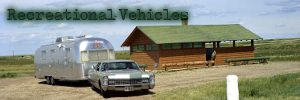|
By accessing or using The Crittenden Automotive Library™/CarsAndRacingStuff.com, you signify your agreement with the Terms of Use on our Legal Information page. Our Privacy Policy is also available there. |

Americans Take RV on Open Road
|
|---|
|
|
Americans Take RV on Open Road
Mike Osborne, VOA News
29 August 2010
 Listen to Americans Take RV on Open Road in MP3 format - 1.0MB - 4:28
Listen to Americans Take RV on Open Road in MP3 format - 1.0MB - 4:28
Home on wheels celebrates 100th birthday
If you've ever watched an old American Western film, then you're likely familiar with the covered wagon.
Long trains of the canvas-topped, horse-drawn wagons, rolling across vast prairies, are an enduring symbol of the nation's pioneering past. The wagons served as both transportation and trail-side home for frontier families.
While the era of the wagon train is long since passed, many Americans still find the home-on-wheels concept irresistible. Today's version is the "recreational vehicle," or RV; often called caravans in other parts of the world.
This year marks the 100th anniversary of the manufactured RV in the U.S., an industry worth $9 billion annually today.
RV country
Folks in North Central Indiana say they grow three crops: corn, soybeans, and recreational vehicles.
You can buy or rent an RV in a dizzying array of shapes and sizes. The smallest can be had for a few thousand dollars - much less than a new car; others can cost a million dollars or more. Some are pulled, some are motorized, and some fit on the back of a pickup truck.
More than half of all American RVs are built in Elkhart County. There's also a sizeable RV museum in Elkhart. Resident historian Al Hesselbart says Americans have always been insatiably curious about what's just out of sight over the next rise.
"The American public, at least a very high percentage of us, have always been vagabonds. We have a huge, beautiful country," says Hesselbart. "An awful lot of us want to take advantage and see as much of that country as they possibly can."
For richer or poorer
According to Hesselbart, RV excursions were a democratic affair from the beginning, with both the rich and the poor enjoying recreational vehicles in equal measure.
"Very popular in the very early days were folding tent trailers, equipped with cooking amenities and covered beds out of the elements and that kind of thing. As well as the motorized vehicles, which, at first, were almost universally targeted towards the ultra-rich."
Hesselbart says Northern Indiana's investment in the RV can be traced to the World Exposition held in nearby Chicago in 1933.
"One of the very finest exhibits at that show was an exhibit by the infant trailer industry. Several Elkhart sons fell in love with the industry at that show; came home and got involved in making, selling, distributing RVs."
Newmar Corporation in Nappanee, Indiana, is just one of dozens of RV manufacturers in the region. Its workforce of more than 400 makes luxury trailers and motor homes. Most of their customers are baby boomers, the unusually large generation of Americans born after World War II, who are now in their retirement years.
Newmar Vice President for Sales, John Sammut, says boomers are changing the travel industry, as they have much of American life. "Baby Boomers seem to be using recreational vehicles in ways that we didn't even imagine, and we're responding as an industry with products that meet the needs and allow these people to have their hobbies, their interests, their passions facilitated in an RV."
Customized
No longer just for family vacations, some Americans are living in their RVs year round, and want all the amenities of home: satellite TV and Internet service, appliances, a full bath, and lots of space. RVs with a built-in garage allow owners to take along motorcycles, golf carts and other toys.
Gail and Don Winter live in their 10-meter-long trailer three to five months a year, and have pulled it through nearly every American state, including Alaska.
"You get to see parts of the country you wouldn't normally see," says Gail Winter. "And you can go places and do things - if you're just vacationing someplace from destination to destination - this way you get to see more of it."
The Winters say the freedom to come and go as they choose is the best thing about an RV, but they also enjoy the relationships that develop at each new campground along the way.
"Some of the best friends we've got, we've met on rallies and we've know for a number of years," says Gail Winter. "You have camaraderie of course. It's very interesting, the people that you meet. We've got friends all over the United States now."
Economic bellwether
The RV industry was hit hard by the economic downturn of the last two years, but Newmar's John Sammut says things are starting to look up.
"Traditionally, the RV industry is on the leading edge of the economy. They're the first to go into a recession and the first to recover from it. So if what we're seeing is any indication and in fact we are the leader, then it should bode well for the rest of the country."
Sammut says the industry is also seeing surprising interest from an unexpected new quarter. He notes that a market for American-built recreational vehicles is beginning to emerge in China.


















 Listen to Americans Take RV on Open Road in MP3 format - 1.0MB - 4:28
Listen to Americans Take RV on Open Road in MP3 format - 1.0MB - 4:28
